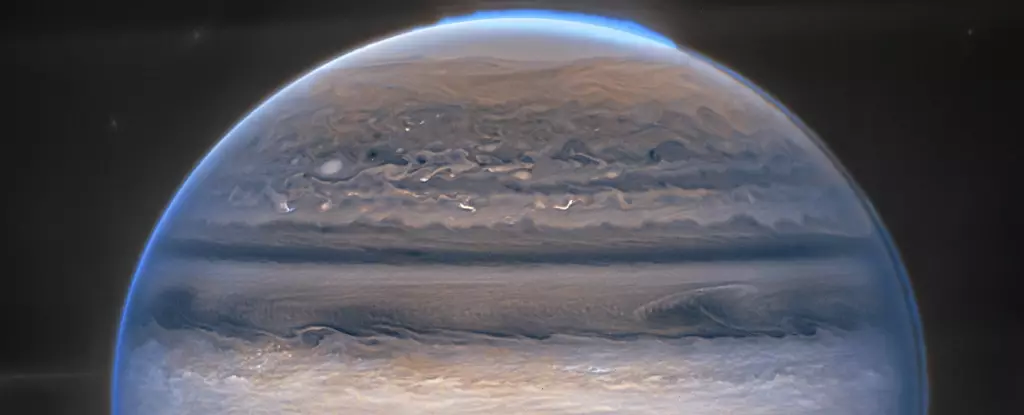Jupiter stands as a monumental figure in our solar system, captivating scientists and astronomers alike. As the largest planet, its sheer size dwarfs Earth, with a volume capable of accommodating over a thousand Earths. However, it’s not just its size that intrigues us; it’s the very nature of this gas giant that challenges our understanding of planetary science. Without a solid surface and composed predominantly of gases, Jupiter raises fundamental questions about planetary structure and the conditions that prevail within its atmosphere.
Unlike Earth, where solid ground provides a familiar landscape, Jupiter is enveloped in thick, swirling clouds of hydrogen and helium. This absence of a solid surface can be hard to conceptualize, especially for those accustomed to the terrestrial experience. Instead of a hard crust, those who explore Jupiter encounter layers of gaseous substance that become denser and more pressured the deeper they go. From the top layers of its atmosphere, where winds howl at speeds exceeding 400 miles per hour, to the crushing depths that reach thousands of miles below, Jupiter presents a hostile environment unmatched in the solar system.
The transition from gaseous hydrogen to liquid states deeper within the planet is gradual, with no definitive point at which we can say solid ground exists. The profound pressure that accompanies these depths reaches levels that would be lethal to us; conditions are more akin to those found in the depths of the ocean than on solid land. Rather than a place where one can land or explore physically, Jupiter seems more like a chaotic entity where the laws of physics are constantly on display in their most extreme forms.
The Core: A Mysterious Heart
What lies at the heart of this gas giant remains a tantalizing mystery for scientists. The core of Jupiter is believed to be a hot, dense mixture of materials, possibly liquid and solid metallic components. However, unlike traditional planetary cores that we might envision as solid rock, Jupiter’s core showcases the complexities of extreme atmospheric conditions. The pressure at this central region is awe-inspiring, estimated to be around 100 million times that of Earth’s atmosphere, akin to having colossal structures compressing down upon a few inches of your skin.
The challenges of probing this core extend beyond just understanding its composition. With temperatures reaching an astounding 35,000 degrees Fahrenheit, any spacecraft venturing too close would likely succumb to heat, melting under conditions hotter than the Sun’s surface. This intriguing yet inhospitable nature reinforces the idea that Jupiter is not just a planet but a complex, dynamic system, one that we are only beginning to understand.
The Guardian of the Inner Solar System
While Jupiter may seem inhospitable for any forms of life we can recognize, its presence plays an essential role in the planetary dynamics of the solar system. Jupiter acts as a gravitational shield, altering the trajectories of asteroids and comets and potentially protecting Earth and its neighboring planets from catastrophic impacts. Without this planet’s formidable gravitational pull, space debris might have collided with Earth throughout history, possibly leading to extinction-level events similar to the one that extinguished the dinosaurs.
This protective influence emphasizes Jupiter’s importance in the broader context of our solar neighborhood. By altering the paths of wandering celestial bodies, it not only contributes to keeping the inner solar system relatively stable but also raises intriguing questions about the formation and evolution of planets.
Despite Jupiter’s inhospitable atmosphere, hope endures within its moons, particularly Europa. This icy moon is the subject of keen interest as scientists speculate the existence of a vast underground ocean beneath its frozen surface. The upcoming NASA mission, Europa Clipper, slated for launch in 2024, aims to explore this moon in great detail. If life exists beyond Earth, Europa may offer some of the best prospects, with its potentially warm ocean providing an environment where microbial life could thrive.
As we anticipate the arrival of the Europa Clipper in 2030, the intrigue surrounding Jupiter only deepens. It serves as both a puzzling giant and a celestial shield, influencing life on Earth in ways we are only beginning to appreciate.
Jupiter, with its turbulent beauty and enigmatic depths, continues to captivate our curiosity, illustrating the complexities of planetary science and the ongoing quest to understand our universe. The journey of discovery is far from over, and as we expand our exploration techniques and technology, we may ultimately unveil the secrets hidden within this majestic gas giant and its intriguing moons.



Leave a Reply